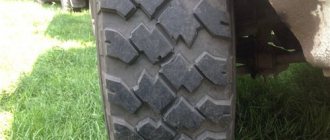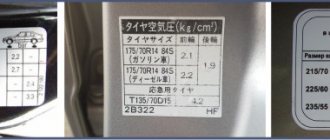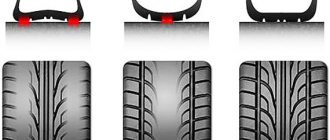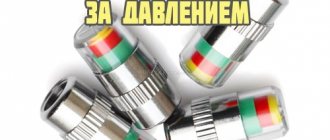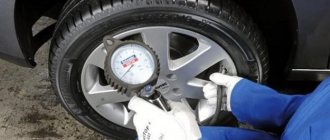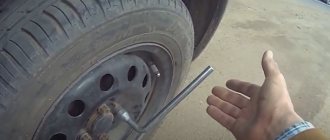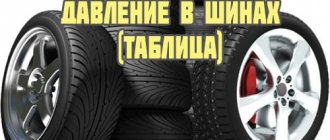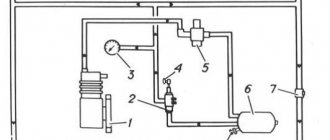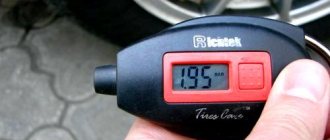The basic version of the VAZ 2104 2104x 2005 1.5D is equipped with 5Jx13 ET29 rims assembled with 175/70 R13 82S tires. Where:
- 5J - rim width in inches;
- 13″ — tire diameter in inches;
- ET29 - disc offset in millimeters.
The vehicle tire marking 175/70 R13 is deciphered as follows:
- 175 — profile width (cross section of the tire) in millimeters;
- 70 - profile height as a percentage of its width;
- R - radial cord winding;
- 13 - tire diameter in inches.
In addition, information about its load capacity and speed parameters can be printed on the rubber - load index and speed index. The load index is a two- or three-digit number; the speed index is indicated in Latin letters, for example 82S:
- 82 - maximum permissible tire load 475 kg;
- S — maximum permissible vehicle speed is 180 km/h.
Using the recommended tire sizes will help you avoid problems with handling, safety and other difficulties. What non-standard sizes can be supplied? Refer to the table; it indicates possible acceptable alternative sizes for tuning. Although there are other options that we have not described in the table. For example, wider discs of the same diameter. Or install wheels of the same width, but with a larger diameter, which is quite popular among car owners. The choice of discs is huge; you can find copies with the same parameters, but with an overhang 1-2 millimeters more or less. It is not possible to list all the options.
At the same time, the bolt pattern for all types of wheels is the same - 4x98. Thus, all disks are mounted on four bolts and the distance between them is exactly ninety-eight millimeters. The car's hub diameter is 58.5 mm.
Standard tire pressure is 1.9 MPa.
VAZ 2104 2104x 2005 1.5i
Generation: 2104x Engine: I4, Gasoline Power: 75 hp (55 kW)
Wheel bolt pattern parameters
| PCD (number of holes x circle diameter) | 4×98 mm |
| Center Hole Diameter (DIA) | 58.5 mm |
| Fasteners | M12 x 1.25 |
| Type of fastener | Bolt |
| Tires | Discs | PCD | Dia | Pressure |
| 175/70 R13 82S Factory kit | 5Jx13 ET29 | 4×98 | 58.5 | 1.9 |
| 175/70 R13 82T Tuning | 5.5Jx13 ET35 | 4×98 | 58.5 | 1.9 |
| 185/60 R14 82T Tuning | 5.5Jx14ET29 | 4×98 | 58.5 | 2 |
| 185/55 R15 82H Tuning | 6Jx15 ET25 | 4×98 | 58.5 | 2.1 |
What wheel sizes does the manufacturer recommend to install?
The VAZ 2104 2104x 2005 1.5i is equipped with 5Jx13 ET29 rims assembled with 175/70 R13 82S tires as standard. Where:
- 5J - rim width in inches;
- 13″ — tire diameter in inches;
- ET29 - disc offset in millimeters.
The vehicle tire marking 175/70 R13 is deciphered as follows:
- 175 — profile width (cross section of the tire) in millimeters;
- 70 - profile height as a percentage of its width;
- R - radial cord winding;
- 13 - tire diameter in inches.
In addition, information about its load capacity and speed parameters can be printed on the rubber - load index and speed index. The load index is a two- or three-digit number; the speed index is indicated in Latin letters, for example 82S:
- 82 - maximum permissible tire load 475 kg;
- S — maximum permissible vehicle speed is 180 km/h.
Using the recommended tire sizes will help you avoid problems with handling, safety and other difficulties. What non-standard sizes can be supplied? Refer to the table; it indicates possible acceptable alternative sizes for tuning. Although there are other options that we have not described in the table. For example, wider discs of the same diameter. Or install wheels of the same width, but with a larger diameter, which is quite popular among car owners. The choice of discs is huge; you can find copies with the same parameters, but with an overhang 1-2 millimeters more or less. It is not possible to list all the options.
At the same time, the bolt pattern for all types of wheels is the same - 4x98. Thus, all disks are mounted on four bolts and the distance between them is exactly ninety-eight millimeters. The car's hub diameter is 58.5 mm.
Standard tire pressure is 1.9 MPa.
What should the pressure be?
For a more comfortable ride, it is necessary to correctly select the pressure in R14 tires. If your route will be on a highway with a smooth asphalt surface, then you need to set the maximum value in the wheels. This will help increase the coasting while driving and give the necessary dynamics, as well as reduce the fuel consumption of your car.
If you go on a trip on dirt or sandy roads, then for high-quality traction, you should inflate the tire to the minimum value. In the urban cycle, the average reading is suitable. This solution will be the best.
VAZ 2104 2104x 2005 1.6i
Generation: 2104x Engine: I4, Gasoline Power: 73 hp (54 kW)
Wheel bolt pattern parameters
| PCD (number of holes x circle diameter) | 4×98 mm |
| Center Hole Diameter (DIA) | 58.5 mm |
| Fasteners | M12 x 1.25 |
| Type of fastener | Bolt |
| Tires | Discs | PCD | Dia | Pressure |
| 175/70 R13 82S Factory kit | 5Jx13 ET29 | 4×98 | 58.5 | 1.9 |
| 175/70 R13 82T Tuning | 5.5Jx13 ET35 | 4×98 | 58.5 | 1.9 |
| 175/65 R14 82T Tuning | 5.5Jx14ET29 | 4×98 | 58.5 | 2 |
| 185/55 R15 82H Tuning | 6Jx15 ET25 | 4×98 | 58.5 | 2.1 |
What wheel sizes does the manufacturer recommend to install?
The VAZ 2104 2104x 2005 1.6i is equipped with 5Jx13 ET29 rims assembled with 175/70 R13 82S tires as standard. Where:
- 5J - rim width in inches;
- 13″ — tire diameter in inches;
- ET29 - disc offset in millimeters.
The vehicle tire marking 175/70 R13 is deciphered as follows:
- 175 — profile width (cross section of the tire) in millimeters;
- 70 - profile height as a percentage of its width;
- R - radial cord winding;
- 13 - tire diameter in inches.
In addition, information about its load capacity and speed parameters can be printed on the rubber - load index and speed index. The load index is a two- or three-digit number; the speed index is indicated in Latin letters, for example 82S:
- 82 - maximum permissible tire load 475 kg;
- S — maximum permissible vehicle speed is 180 km/h.
Using the recommended tire sizes will help you avoid problems with handling, safety and other difficulties. What non-standard sizes can be supplied? Refer to the table; it indicates possible acceptable alternative sizes for tuning. Although there are other options that we have not described in the table. For example, wider discs of the same diameter. Or install wheels of the same width, but with a larger diameter, which is quite popular among car owners. The choice of discs is huge; you can find copies with the same parameters, but with an overhang 1-2 millimeters more or less. It is not possible to list all the options.
At the same time, the bolt pattern for all types of wheels is the same - 4x98. Thus, all disks are mounted on four bolts and the distance between them is exactly ninety-eight millimeters. The car's hub diameter is 58.5 mm.
Standard tire pressure is 1.9 MPa.
General background information
Ranges of possible values for tires and wheels VAZ 2104 2005.
Tires
| Diameter | 13″–15″ |
| Width (mm) | 175–185 |
| Profile (%) | 55–70 |
| The smallest size | 175/70 R13 |
| The biggest size | 185/55 R15 |
Wheel disks
| Diameter | 13″–15″ |
| Width (inches) | 5–6 |
| Reach (mm) | 25–35 |
| Drills | 4×98 |
Expert advice
When choosing tires for a car, you must first follow the manufacturer's instructions. Ask yourself a few questions.
- On what roads will the car be primarily used?
- Do you need increased cross-country ability?
- How much of the route will be city roads and how much will be highways?
- Will the vehicle carry heavy loads?
The answers to these and similar questions will help determine which tire parameters you need to pay special attention to.
How to choose the right wheels for a VAZ 2104 2005?
3 types of rims:
- Stamped (economical price category) - made from a sheet of iron by stamping on a press.
- Light alloy - manufactured by casting (more reliable than stamped ones).
- Forged (the highest quality and more expensive than the previous ones) - made from light alloys by stamping at high temperatures.
The choice depends on financial capabilities. However, it should be borne in mind that the quality of the road surface on which you have to drive every day must also be taken into account.
So, if it gets into a hole, a stamped disk will bend and will not cause harm to the tire, but a forged or cast one can cut it. There is a possibility that the cast disc may burst or crack.
It should also be noted that repairing “stamping” wheels is cheaper than repairing cast or forged wheels. But wheels with high-quality cast and forged disks kill the suspension less, because lighter and have more perfect geometry (better balanced).
The same wheels may or may not rub with tires on the same car - wheel alignment adjustment will help here.
What is the tire pressure?
It is the driver's responsibility to constantly monitor tire pressure. This will avoid standard problems associated with vehicle operation. An abnormal pressure value often causes:
- deterioration of management;
- uneven tread wear.
Often the car owner independently reduces the pressure in the wheels of his own vehicle. This reduces the load on the suspension, and the car “passes” various road irregularities an order of magnitude easier. But it is worth noting: a decrease in pressure even by 0.1 MPa leads to serious problems. The main ones include:
- increased fuel consumption;
- rapid wear of the outer tread segments;
- the car becomes less maneuverable.
An overinflated wheel causes no less problems. The central part of the cylinder begins to wear off quickly. In addition, at ambient temperatures of more than 60 degrees Celsius, the tire may simply explode. Which will lead to driving into the oncoming lane.
© 2019-2021 Avto Sprav. Directory of factory parameters of disks and tire sizes.
Attention! Our catalog is an information resource and does not guarantee full compliance of the proposed dimensions with your car. Make sure that your car has wheels of the appropriate radius.
VAZ cars can be considered one of the most famous brands in the post-Soviet space. Today you can find both old VAZ-2106 and models 2107. Samara 2109 and 21099 are quite common. Fans of the domestic automobile industry today are purchasing more modern models: VAZ 2110, 2112, 2114 and 2115. This suggests that even with With the appearance on the market of a large number of affordable foreign cars, cars from the Volzhsky plant have not ceased to be in demand among car enthusiasts.
It is important to always know the tire pressure of your car
In order for the service life of the car to be long enough, it is necessary to strictly adhere to all conditions of proper operation. Among the various factors that determine the proper use of a car, tire pressure is very important and significant.
How to measure blood pressure: the correct sequence
Alas, even the majority of experienced drivers completely ignore the procedure for monitoring the tire pressure of a car, considering this procedure absolutely useless. Checking tire pressure is carried out using a pressure gauge, which can be integral with the pump, or be a separate element. Do not forget that the error of any pressure gauge is usually 0.2 kgf/cm 2.
Pressure measurement sequence:
- It is necessary to reset the pressure gauge readings.
- Unscrew the safety cap (if equipped) from the wheel nipple.
- Connect the pressure gauge to the nipple and press it lightly to release air from the chamber.
- Wait until the instrument needle stops.
This procedure must be performed monthly during regular use of the vehicle. The measurement should be taken before leaving, when the tires are not yet warmed up. This is necessary to accurately determine the readings, since after the tires warm up, the air pressure inside them increases. This is often caused by dynamic driving with constant changes in speed and sudden braking. For this reason, it is ideal to take measurements before driving, when the tires on the car have not yet warmed up.
Car tire pressure, how important is it?
The manufacturer always gives recommendations regarding the tire pressure of the car. There is a special table where, depending on the model and type of tire, it is indicated what the value should be for different types of cars.
However, we should not forget that it also depends on load distribution, ambient temperature and other factors.
Control measurement of tire pressure on a VAZ 2106 car
With overinflated wheels we observe the following:
- reduction of drag coefficient;
- lower degree of deformation;
- smaller contact patch with the road;
- reduced shock absorption;
- increased controllability.
When the wheels are underinflated, the following phenomena are observed:
- increasing the size of the contact patch with the road;
- increasing the resistance coefficient;
- increased fuel consumption;
- improving the smoothness of the ride;
- deterioration in vehicle controllability.
In both the first and second cases, tread wear increases. In the first case, the middle of the tread deteriorates, in the second, the sidewalls.
Review of the best summer and winter tires
It is better to acquire separate sets of summer and winter tires in advance. Pirelli Cinturato P1 Verde tires are ideal for the warm season. Their cost is relatively high (from 3,500 rubles per 1 tire). However, they perform excellently on wet asphalt and are highly resistant to wear.
- Continental Conti Premium Contact 5 is well balanced. There are a large number of special drainage channels - they make it easy to drain water from the contact patch. This kit will cost slightly less than the one discussed above.
- Goodyear EfficientGrip Performance provides good grip and low fuel consumption. However, the tread thins out quite quickly - especially during intense driving. The rubber is soft and handles well. Despite its softness, it is difficult to damage it redder.
- Dunlop Sport BluResponse is relatively cheap compared to all the options discussed above. However, it has its weaknesses. For example, on wet asphalt the wheels slip a lot and handling deteriorates.
- Semperit Comfort-Life 2 is a rare guest on Russian territory. However, on dry asphalt at positive temperatures it performs more than well. However, rubber is distinguished by its noise.
- GOODYEAR 175/70R14 UG ICE ARCTIC D-STUD - studded tires at a relatively low cost. Regardless of the ambient temperature, it retains its flexibility and softness. Cost – from 4,000 rubles.
- HANKOOK 175/70R14 W429 is a more budget option. Cost – from 2,800 rubles. Thanks to the deep tread and flexible design, the driver can feel completely safe on the road.
- KUMHO 175/70R14 WI31 84T usually costs several hundred rubles cheaper than the modification discussed above. The presence of studs makes this tire safe on almost any road.
- VIATTI TIRES 175/70R14 BRINA NORDICO is manufactured using rubber mixing technology. Reinforced lugs make this model indispensable not only in winter, but also on dirt roads in summer.
- SAVA 175/70R14 ESKIMO ICE MS is the most profitable option. It has a relatively low price (from 2,000 rubles). There are no thorns. However, the deep tread and its shape provide high-quality, reliable contact with any surface.
Choosing suitable tires for the VAZ 2110 is a relatively simple process. However, it is important to familiarize yourself with the intricacies of tire selection in advance. Wheels that are too large can easily damage the vehicle body.
Source
Tire pressure table for different VAZ car models
The table below shows what the tire pressure should be for various VAZ car models. We provide an incomplete list, older types, like the VAZ-21099, and newer cars: VAZ-2110, 21111 and 21112.
Table of recommended tire pressure for VAZ cars
In winter, it is customary to lower the wheels a little, although it is officially stated that the degree of inflation does not depend on the season. However, lowered wheels provide the following advantages:
- better stability on slippery roads;
- smooth ride of the car;
- reducing braking distance and reducing the likelihood of an emergency.
Is it worth it or not to inflate your tires with nitrogen?
Recently, almost all tire stations have introduced the expensive service of filling tires with nitrogen. Its popularity is due to a number of the following opinions:
- Thanks to nitrogen, the pressure in the tires remains unchanged when they heat up.
- The service life of rubber increases (it practically does not “age”, since nitrogen is much cleaner than air).
- Steel wheel rims are not subject to corrosion.
- The possibility of tire rupture is completely eliminated, since nitrogen is a non-flammable gas.
However, these statements are nothing more than another advertising ploy by marketers. After all, the nitrogen content in the air is about 80%, and it is unlikely that anything can change for the better if the nitrogen content inside the tires increases by 10-15%.
In this case, you should not spend extra money and inflate the wheels with expensive nitrogen, since there will be no additional benefit, as well as harm, from this procedure.
Many novice car enthusiasts, when purchasing a vehicle, often wonder what the standard pressure parameters for R14 tires should be? Lack of professional knowledge in car maintenance and professional training in car operation very often becomes the reason for the owner’s elementary forgetfulness to check the tire pressure. As a rule, this is considered a serious error and directly affects the controllability of the vehicle, which can lead to a serious emergency situation on the road and dire consequences. But let's talk about everything in order.
Check your car tire pressure regularly
Owners of VAZ cars, like any other brands, are recommended to regularly check the level of tire inflation - at least once a month. Practice shows that over the course of a month the pressure decreases by 0.4 atmospheres. In this case, it is necessary to pump up the wheels.
To measure, you don’t have to constantly go to a service station - you can do it yourself using a pressure gauge. We do it this way:
- We reset the device readings.
- Remove the cover from the spool.
- We put the fitting of the device on the nipple and press.
- We take readings from the device.
Since temperature can significantly affect the readings, it is necessary to take them before leaving the garage on “cold” tires. Remember that regular monitoring is the key to your safety and long vehicle life.
METHODS OF MEASUREMENT
How to measure the tire pressure of VAZ cars? The measurement can be made using a special dial pressure gauge, but it should be noted that they may have an error of 0.2 atm. The pressure gauge can be either a separate device or as part of a wheel inflation pump.
We measure the pressure very simply:
It is recommended to take measurements at least once a month if the machine is used regularly. It is recommended to check tire inflation before leaving the garage after a long stay.
Pressure may increase when tires heat up. This often happens if the driver prefers a dynamic driving style with frequent and sharp braking. Therefore, measurements are taken on the car before the trip, when the wheels have not yet warmed up.
Optimal car tire pressure
The main task of car tires is to provide effective traction between the car and the road. With normal air pressure in the tire, the load in the contact patch of the wheel with the road is distributed evenly, due to which tire wear occurs evenly, the car handles well and fuel consumption is within normal limits.
There are three possible scenarios in which the tire pressure will not be optimal:
- Increased pressure (tires overinflated);
- Low pressure (tires underinflated);
- Different pressure in all wheels.
Check the tire pressure with a special tire pressure gauge. This should only be done on cold tires, that is, before leaving the parking lot or garage.
If deviations from the normal pressure are detected in any of the tires (see the table below for what pressure should be in the tires of your passenger car), such a wheel must either be inflated or excess air released from it - that is, the pressure must be adjusted to norm. In one of our articles, we already talked about which car compressor is best for inflating tires.
It is worth noting that the tire pressure in winter should be exactly the same as in summer. But due to the sharp temperature change, in winter, monitoring the air pressure in the wheels needs to be approached more responsibly.
It is better to inflate your tires outside. Also, do not forget to check the tire pressure when there are significant changes in ambient temperature, and if necessary, adjust it:
- if it gets cold outside, the pressure in the tires will decrease,
- and when it gets warmer, it will rise.
It should also be remembered that while the car is moving, the tires heat up, the air in them expands, and the pressure increases, and the handling and braking properties change.
Increased tire pressure
With increased tire pressure, the load at the point of contact of the wheel with the road acts to a greater extent on the central part of the tire tread, thereby causing uneven wear of the tire.
On overinflated wheels, the car brakes worse! This happens because if the tires are overinflated, the contact patch with the road decreases, which means the friction force that keeps the car from sliding decreases. At the same time, the braking distance increases noticeably.
In just twenty minutes of driving, taking turns as aggressively as possible, the pressure in the car’s tires can increase by 0.5 atmospheres. And on long trips at high speed, the pressure in the tires can increase to 4-5 atmospheres. And modern tires are designed for this.
But if the tire has a hernia or cut, it can heat up and explode while driving. But on the road it’s a disaster.
Low tire pressure
Wheels lowered to just half an atmosphere change the behavior of the car and become unusable much earlier than expected. When the pressure is low, the load on the tire surface is distributed unevenly. In this case, the sidewalls of the tire where the tire contacts the road are subject to increased wear.
The sidewalls of flat tires are softer and bend when you turn the steering wheel. The trajectory of the wheel and tire do not match, so the car responds to the steering wheel late.
Moreover, if the tire pressure is reduced, the wheel may even come off during a sharp turn. Therefore, it is very important to regularly check the tire pressure and maintain it within the normal range.
This is especially true in winter, since in cold weather the tire pressure can easily drop by 0.3 (or even 0.5) atmospheres.
It is also worth keeping in mind that low air pressure in the wheels leads to increased fuel consumption. Just in case, we remind you that our website has an excellent selection of tips on how to reduce fuel consumption in a car - be sure to read it, you will probably find something new for yourself.
Different pressure in car tires
The most common situation among drivers is when the pressure in all wheels is different. There can be many reasons, for example:
- Faulty spool valves;
- Uneven tire wear;
- Or perhaps you caught a nail with the wheel.
During emergency braking, in this case, the coefficient of road adhesion between inflated and lowered wheels will be different, which with a high degree of probability will lead to the car skidding or turning across the road.
If the car starts to pull even a little to the side, there is a reason to check how the tires are inflated. And remember that tires don’t last forever. Even very good tires need care.
INFLUENCE OF WEATHER CONDITIONS AND ROAD FACTORS
The pressure in VAZ tires in summer should, in principle, be the same as in winter. But in practice in winter it is made a little lower for a number of reasons:
It is necessary to take into account the fact that after a temperature change (after leaving a warm garage on a frosty street), the pressure in the R14 tires will become less due to physical factors. Therefore, you should check it before you hit the road and, if necessary, pump up the tires. Also, when it gets warmer after winter, pressure measurements should be taken.
The pressure in R13 tires in summer is usually maintained at 1.9 atm, but this level is designed for an average vehicle load (two or three people in the cabin). If the car is fully loaded, then the pressure should be increased on the front axle to 2.0-2.1 atm., on the rear axle to 2.3-2.4 atm. The spare wheel is inflated to 2.3 atm.
Russian roads are not of good quality, and therefore many car owners deliberately lower the tire pressure somewhat so that all the unevenness of the road surface is not so noticeably felt when driving. Typically, in summer the wheels are lowered by 5-10%, and in winter by 10-15% of the norm. On flat roads you can stick to the factory standard.
Tire pressure tables by car make and wheel size
Below we provide a table of tire pressures for domestic VAZ, GAZ and UAZ cars. If you need a tire pressure table for foreign cars, you can download it from this link.
Imagine the following situation - you come to a tire service, say, to change seasonal tires. The worker asks you: “How long should I pump the wheels? What pressure should I set? This moment causes stupor for many. In this article you will learn what pressure to pump into the tires of a car and what it affects.
We all know that a wheel consists of a disk, which provides structural rigidity, and a tire, inflated with air, which absorbs road unevenness. If the air pressure does not meet the recommended value, the driving characteristics of the car and the performance characteristics of the tires change. If there is no pressure at all in the tire and it does not inflate, it needs to be replaced with a spare tire and you cannot drive it.
If the wheels are underinflated (pressure below normal)
The contact patch with the road increases, resulting in increased tire wear and fuel consumption. The risk of disc damage on potholes and bumps increases due to insufficient elasticity of the tire.
If the wheels are overinflated (pressure is higher than normal)
The contact patch with the road decreases and traction deteriorates. The tire is more elastic, comfort deteriorates, and every bump is felt when driving. The car's suspension is exposed to more severe impacts and there is a high risk of it breaking. A worn, overinflated tire can burst at high speed.
How to measure tire pressure?
Pressure is measured by a special automobile pressure gauge, which can be mechanical, electronic, or included with a pump. The measurement must be carried out on cold wheels before driving, since when driving the wheels heat up and the pressure inside the tire increases. It is advisable to do this at least once a month, and carry out a visual inspection of the wheel before each trip. A slight decrease in pressure (up to 0.5 atmospheres) is not noticeable from the outside, but a more serious loss of air can be seen. Measurements must be taken on each wheel.
What should be the pressure in a car's tires?
The average normal tire pressure is 2 atmospheres. But for different cars and different wheel sizes, this figure changes slightly. Recommended values are indicated in the operating instructions, as well as on the car itself in standard places - the back of the gas tank cap and the middle pillar near the driver's door.
Tire pressure in winter
In winter, the tire pressure is set to the same as in summer. The automaker doesn't differentiate between seasons, which means we won't either. The only point is that when parking the car outside at low temperatures, the pressure in the wheel can decrease by 0.2 atmospheres. Once you start driving, the tires will warm up and the pressure will equalize.
So, in this article you learned that tire pressure is a very important parameter that needs to be periodically monitored and set to the recommended values. A discrepancy between the pressure and the required value can lead to deterioration in vehicle handling, poor traction, rapid tire wear, not to mention the more dire consequences of a wheel exploding at speed.
Keep your tires inflated
The pressure inflated into tires depends on what size they are. In addition, the pressure is also different for the front and rear wheels of the car. So, in relation to the VAZ 2107, for the front wheels it is 1.6-1.7 atm, for the rear wheels - 1.9-2.0 atm
. Tires are usually inspected at least once every two weeks.
When checking, you should take into account what external factors may affect the reliability of the measurements. These factors include ambient and tire temperature. The higher the temperature, the higher the pressure, and vice versa. Therefore, it is recommended to carry out a mandatory check when there are significant changes in temperature, for example before winter.
To check and adjust pressure, you must have the following instruments/equipment:
- Car pressure gauge;
- Compressor or pump.
Despite the fact that most automobile compressors have a built-in pressure gauge, the most accurate measurement result is obtained with a separate pressure gauge, since there are no extraneous forces during the measurement, such as compressor pressure. If, according to the measurement results, the pressure is below normal, it is pumped up using a compressor or pump; if it is higher, it is released by pressing the spool, or a special button on the pressure gauge (if available).
Incorrectly adjusted tire pressure on a VAZ 2107, in addition to threatening traffic safety, can lead to premature wear of the chassis or damage to the tires. As a result, repairs will cost hundreds of times more than timely inspection. It is also important that the wheel size matches the design features of the machine. Sometimes, in pursuit of beauty, some car enthusiasts install wheels whose size exceeds the permissible size for a given model, and as a result, chassis elements fail.
Advice when choosing a compressor: don’t look at the size; big doesn’t always mean powerful. Choose a compressor of appropriate capacity, taking into account the size of your car's wheels. Also pay attention to what working elements it has - plastic ones are less durable than metal ones.
